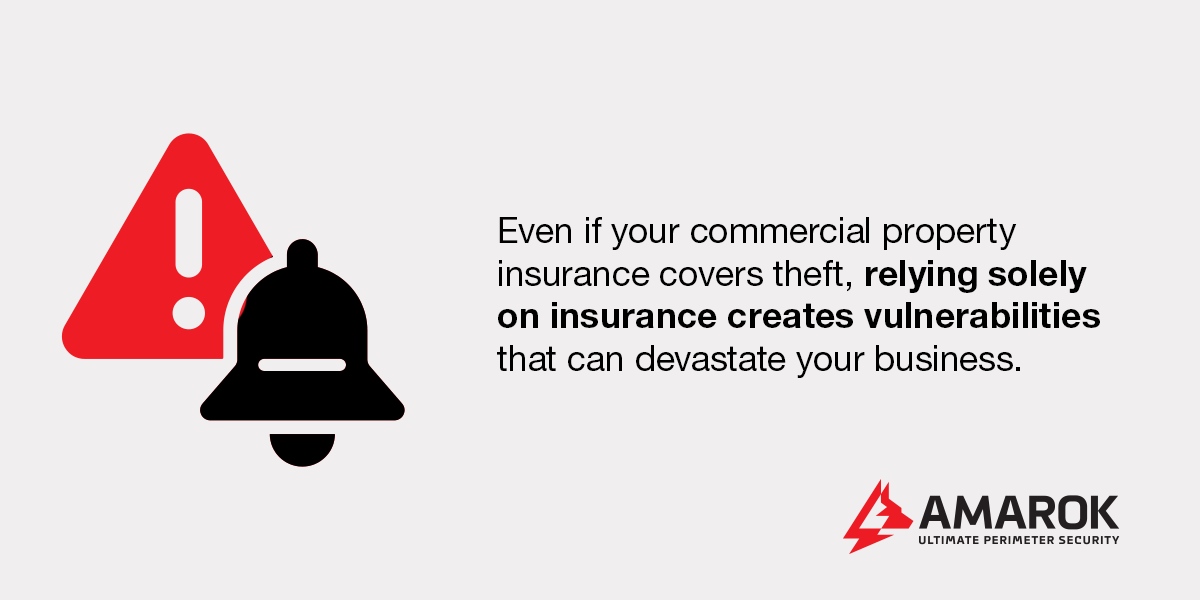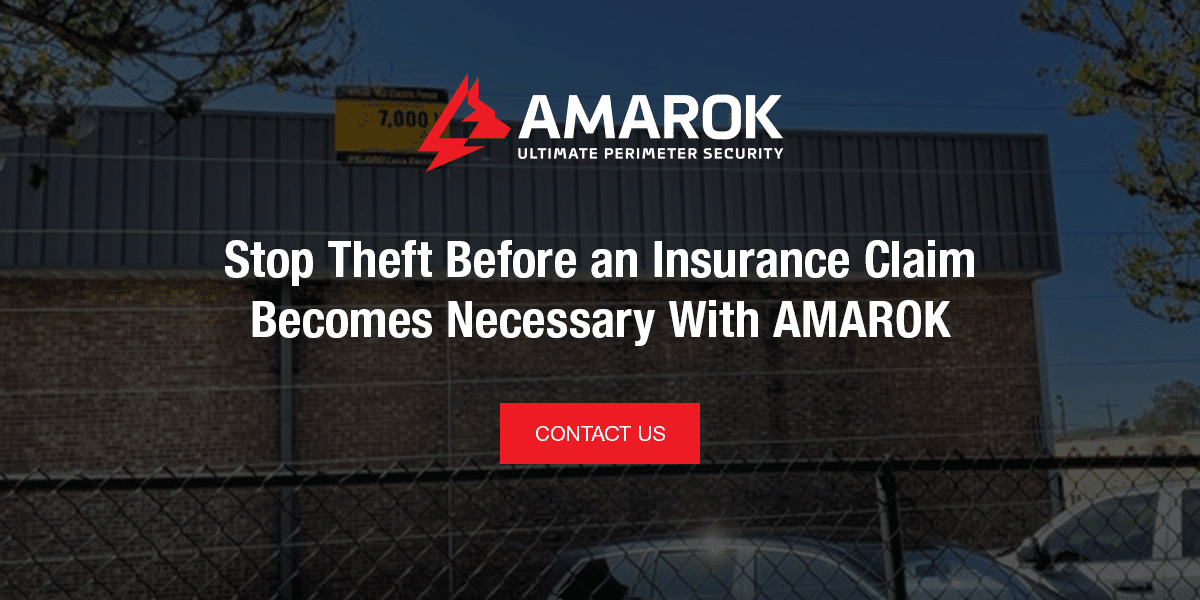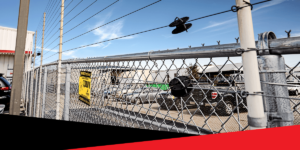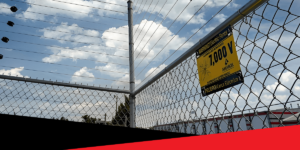You’ve got insurance, so you should be covered if there’s theft at your business, right? Not so fast. Too often, businesses become complacent because of the false sense of security that insurance provides, leading to tragic results.
There are several hidden ways that insurance can let you down when you need it most. From skyrocketing premiums with every claim, to being dropped if you have too many claims, to multiple deductibles and hidden gaps in coverage, insurance is not always the reliable safety net you think it is.
Is Your Property a Target for Thieves?
Commercial properties attract criminals for specific reasons. Understanding what makes your business vulnerable helps you take proactive steps to protect your assets before thieves strike.
Thieves typically target commercial properties with high-value items that are easy to resell. For example, construction sites lose up to $1 billion annually to equipment theft, with excavators, loaders, and generators topping the list. Auto dealerships and repair shops face a catalytic converter theft epidemic, with replacements costing thousands of dollars.
Metal recycling facilities, trucking companies, and equipment rental yards attract thieves seeking copper wire, aluminum, tools, and vehicle parts. These items move quickly through resell markets with minimal traceability. Thieves also target businesses that lack perimeter security measures — the following can make you an easy target:
- No perimeter fencing
- Limited lighting or evidence of video surveillance
- Predictable closing times and minimal after-hours activity
- Easy access points through unsecured gates or doors
- Valuable inventory stored outdoors or in vulnerable structures
Does Commercial Insurance Cover Theft?
Business insurance could cover theft — it depends on your specific policy terms, the type of theft, and how it occurred. Most standard commercial insurance policies cover theft of business property, but with significant limitations.
Generally, business insurance covers robbery (theft involving force or threats). However, mysterious disappearance, internal theft, and certain types of burglary may require additional coverage.
Commercial property insurance is what your business needs to be covered in the event of property theft and damage. This type of insurance covers your building, inventory, on-site assets, office supplies, computers, and equipment from covered incidents of theft, fire, storms, and vandalism.
Common types of theft scenarios that commercial property insurance covers include:
- Forced entry burglary with evidence of break-in
- Robbery involving threats or violence
- Theft of property from secured premises
- Damage to buildings during theft attempts
Insurers often exclude or limit coverage for the following:
- Internal theft by employees, which requires separate fidelity coverage
- Inventory shortages discovered during audits
- Theft from unlocked vehicles or buildings
- Property left unsecured outside business hours
Types of Commercial Property Insurance
Businesses usually require a combination of policies to cover all of their bases. Here’s a detailed breakdown of common policies:
- Commercial property insurance: Commercial property insurance covers the physical assets of your business, such as your building, office equipment, and inventory.
- Professional liability: This type of insurance covers professionals from errors and omissions that cause damage to another party.
- Commercial auto: Commercial auto insurance covers vehicles used in service to your business. It is needed for both your company vehicles and for any time a privately owned vehicle is used for business purposes.
- Commercial umbrella insurance: Commercial umbrella insurance adds an extra layer of protection by covering losses that exceed the limits of your current insurance coverage.
- Employment practices liability: This type of insurance protects your business if you are sued for a violation of labor practices, such as discrimination or wrongful termination.
- Workers’ compensation insurance: Workers’ comp helps you provide pay and medical benefits to workers who have been injured on the job.
- Cyber liability: Cyber liability covers your company from damages resulting from data breaches and cybersecurity problems.
- Business interruption insurance: This type of business insurance provides theft coverage, including lost income as a result of a covered event, such as a fire or storm damage
Working with an insurance agent helps ensure you have adequate coverage. Keep in mind that even comprehensive policies have limitations when it comes to theft protection. Your agent can review your specific risks and recommend appropriate coverage levels.

Shortcomings of Commercial Insurance
Even if your commercial property insurance covers theft, relying solely on insurance creates vulnerabilities that can devastate your business.
Thieves Are Likely to Strike Again
In truth, if you have experienced theft, your business is a bigger risk to the insurance company because thieves who have successfully robbed a place once are likely to strike the same place again. If thieves already know how to get in, access valuable items, and get out without getting caught, it simply makes sense that they’d keep hitting the same target (your business) that presents a high probability of success.
Increasing Premiums
Your insurance company sets premiums based on risk assessment. Filing just one theft claim signals higher risk, triggering immediate rate increases. According to industry data, businesses see a 5% to 25% increase after a single claim. For a company paying $30,000 annually for $10 million in coverage, that’s an extra $1,500 to $7,500 per year.
Compounding Premium Increases
With each commercial insurance claim, premiums don’t just increase — they compound. For example, if a business experiences three thefts in a year and files a claim for each incident, that business could expect its premiums to increase by a specific percentage each time.
For example, a business that files three claims with a rate increase of 20% would increase its insurance premiums as such:
Initial premium: $30,000 per year for $10 million coverage
- After 1st claim: $30,000 x 120% = $36,000 per year premium
- After 2nd claim: $36,000 x 120% = $43,200 per year premium
- After 3rd claim: $43,200 x 120% = $51,840 per year premium
With three theft claims, the business’s annual premium would almost double from $30,000 to $51,840 a year for the same coverage. That $51,840 a year will only increase in the future with yearly rate hikes, compounding the expense of each theft even further.
Multiple Deductibles
Imagine that thieves break into your parking lot and steal five catalytic converters from five different delivery trucks. Your insurance deductible is $1,000. You think, “Ugh, that’s $1,000, but at least everything is covered.” Not exactly.
You see, the deductible is per unit covered, not per incident. That means you’ll be paying $5,000 in deductibles, $1,000 for each vehicle. At that point, it might be more cost-effective to pay out of pocket for the stolen catalytic converters, considering how much your business will pay in deductibles plus the increase in insurance premiums after filing a claim.
Theft Claims Are Often Denied
Insurance companies are notoriously hard to deal with. After all, they don’t make money by paying out every claim that’s filed. There’s a long list of reasons why your business insurance might deny your theft claim, including:
- You don’t have proper documentation that the items were ever in your possession or were actually stolen.
- You can’t provide evidence of an actual break-in. This can occur if an employee left a door or gate unlocked and a criminal walked right in, leaving no signs of forced entry.
- You can’t provide an accurate valuation of the items stolen.
- Your organization did not perform proper preventive maintenance on your perimeter security fence, gates, locks, windows, doors, or security system.
- You may not have the right kind of business insurance.
The world of commercial property insurance can be complicated. It’s no wonder business owners don’t know if they’re covered for theft until it’s too late.
The Bottom Line: Relying on Insurance to Cover Losses Isn’t Sustainable
Commercial property insurance exists as a last resort, not a primary protection strategy. Between deductibles, premium increases, coverage limitations, and claim denials, depending on insurance alone leaves your business at risk of financial devastation.
Stop Theft Before an Insurance Claim Becomes Necessary With AMAROK
Don’t let insurance limitations leave you vulnerable. While commercial property insurance is a financial safety net, a unified perimeter security system prevents theft from happening in the first place. AMAROK is an award-winning, industry-leading perimeter security solutions provider. With The Electric Guard Dog™ Fence, 99% of AMAROK customers experience zero external theft.
Protect your assets before thieves strike. Contact us today or request a free threat assessment to get started.





